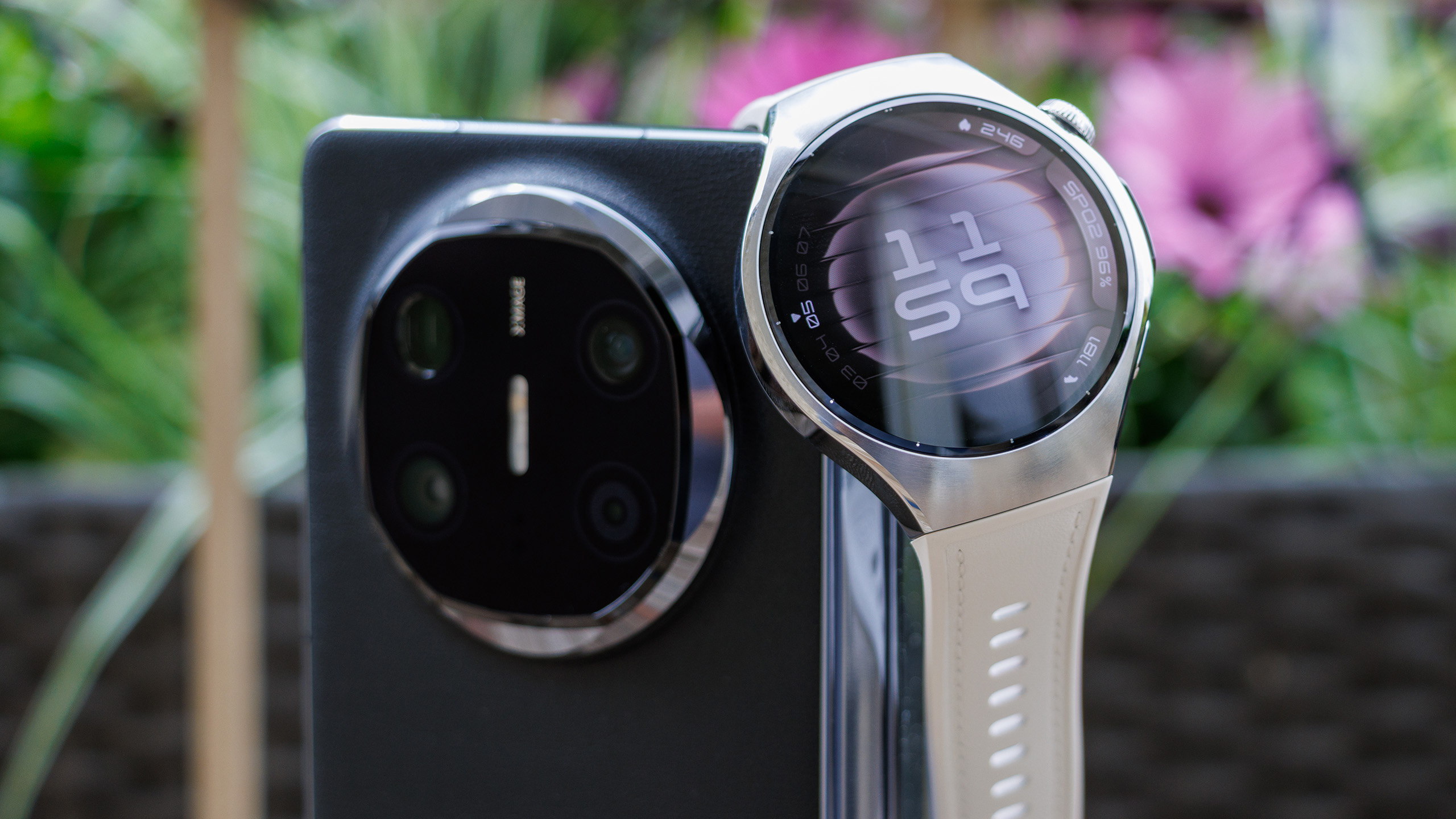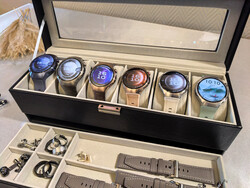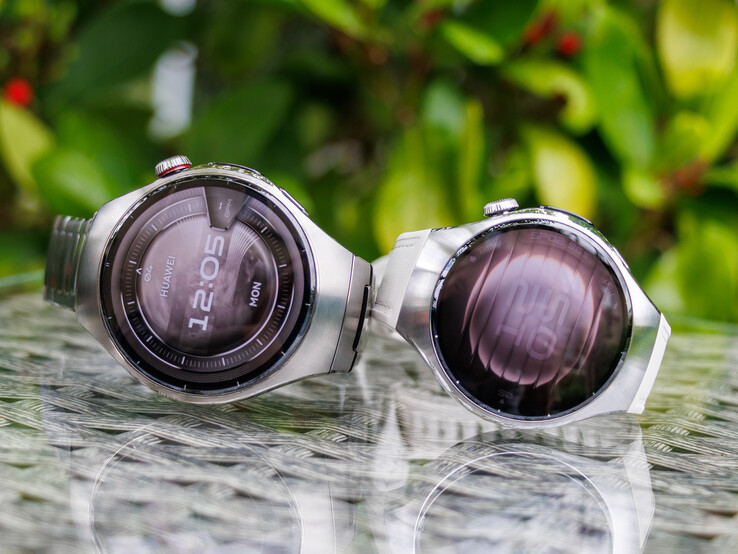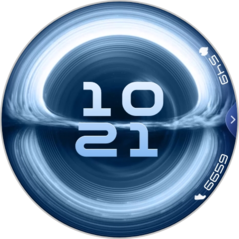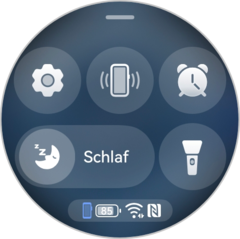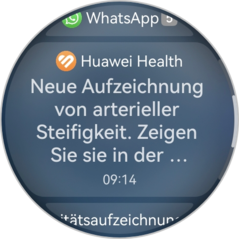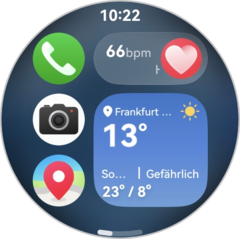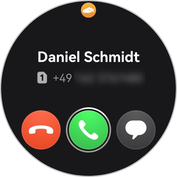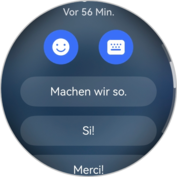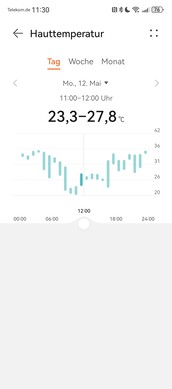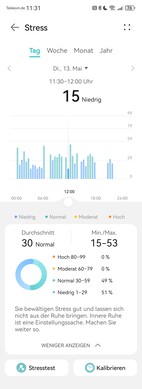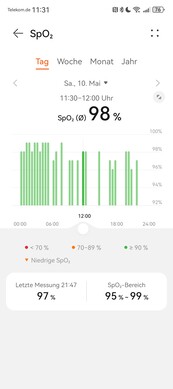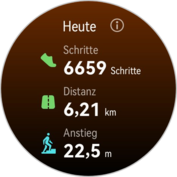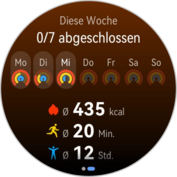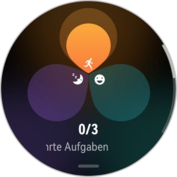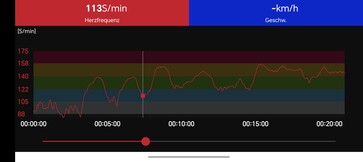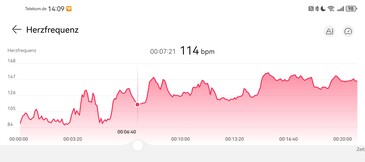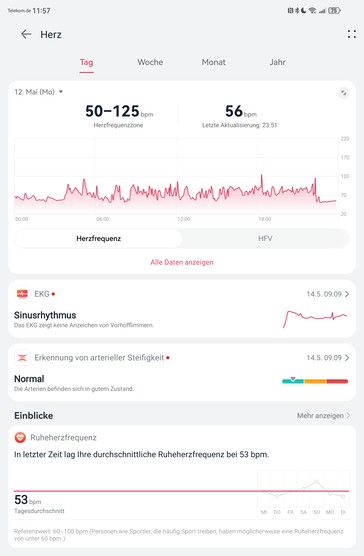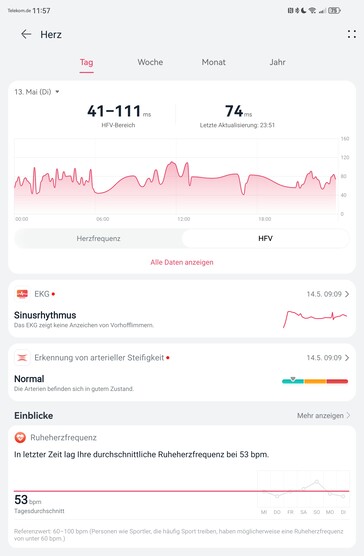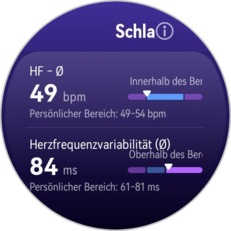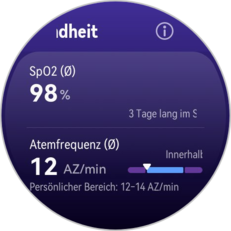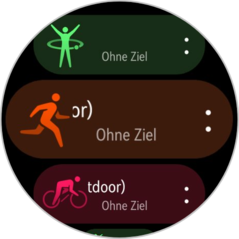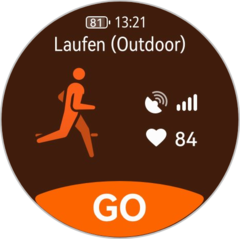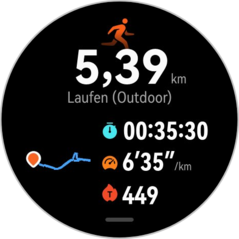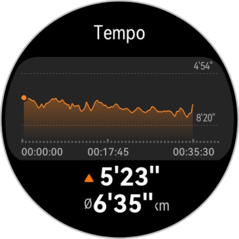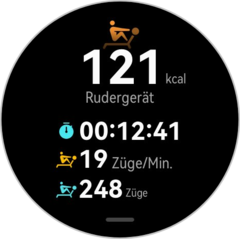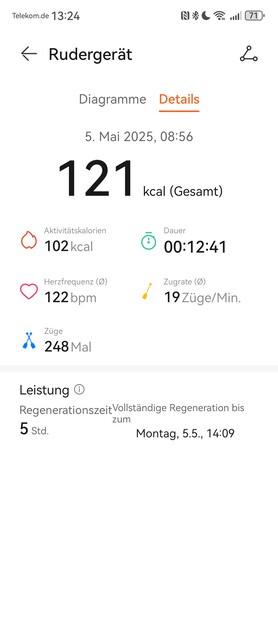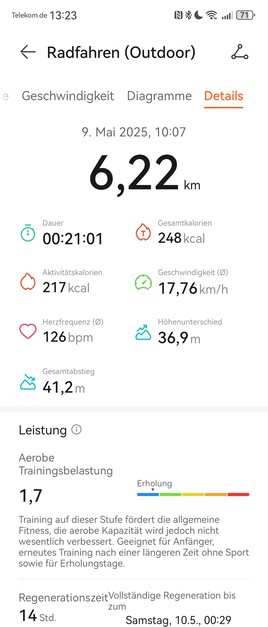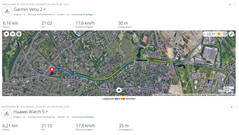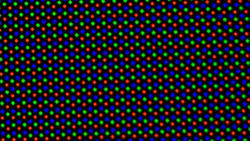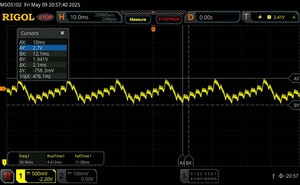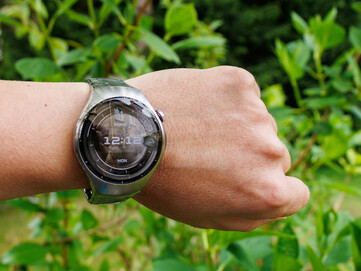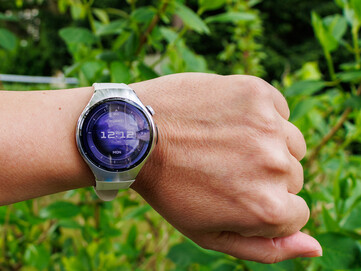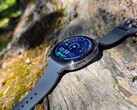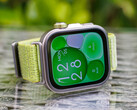Verdict - Versatile and long-lasting
In our test, the Huawei Watch 5 shows itself as a technologically matured and high-quality smartwatch that is offered in two sizes and various alloy materials. It scores with an attractive and robust case, a very bright OLED display, and numerous health and fitness functions. Particularly the new X-Tap sensor stands out, allowing for fast and accurate measurements of several vital parameters in a short time.
During sports tracking, the watch also impresses with a large variety of data and numerous supported activities. Compared to the competitors, the battery life is above average, particularly in power-saving mode. The watch is compatible with both Android and iOS, even though several functions are limited with iOS. Although there are some compromises with NFC payments, it is basically supported. Overall, the Huawei Watch 5 offers a strong package for health and sports-oriented users with high demands on the design and technology.
Pros
Cons
Price and Availability
While the Huawei Watch 5 is available in many countries such as the UK costing £400-500 (~$534-668), in the US it is only available from import vendors on Ebay or AliExpress, for example.
Table of Contents
- Verdict - Versatile and long-lasting
- Case and Equipment - Huawei Watch 5 comes in two sizes
- Setup and Operation - Compatible with both Android and iOS
- Health and Fitness - Measuring faster and more accurately with the X-Tap sensor
- Display - The Huawei Watch 5 gets very bright
- Performance and Battery Life - Smooth HarmonyOS 5.1
- Possible Alternatives in Comparison
The newest generation of Huawei's premium smartwatches does without any naming addons such as Pro, Ultra, or Ultimate and is simply called Watch 5. It follows the Watch 4 Pro or Watch 4 Pro Space Edition and uses HarmonyOS Next for the first time, even though it still remains compatible with Android and iOS.
For the first time, Huawei also offers a smaller version of the watch, using three different kinds of materials. Dependent on the material and watchband, the Watch 5 starts from 449 Euros (~$505), with the most expensive version costing 649 Euros (~$730).
Case and Equipment - Huawei Watch 5 comes in two sizes
Huawei offers a total of eight versions of the Watch 5, with four versions each for the 46mm and the 42mm size (~1.8 and 1.65 in). The larger size is offered in three versions of a case made of an aerospace-quality titanium alloy and one version of stainless steel (316L). Huawei specifies a display-to-surface ratio of 80.4%. The titanium case is available in silver (either with a titanium or a brown composite watchband) or in purple (with a composite watchband). The stainless-steel model comes in black. The watchbands can be switched without needing tools using the 22mm quick release, and the links of the titanium watchband can also be added or removed without tools.
The 42mm model is available in Sand Gold with a titanium or composite watchband, and its case is made from high-quality stainless steel (904L). Both silver versions use 316L stainless steel and come either with a green Fluoroelastomer or white artificial leather watchband. You can also use other 18mm watchbands. At 82.5%, the display-to-surface ratio is even better than that of its larger sibling model. All smartwatches of the Watch 5 series are protected by spherical Saphire glass that turned out to be very robust and resistant against scratches in our test.
The Huawei smartwatches aren't very heavy at 56 grams (~2 oz) for the large version of the titanium model (without the watchband) and 61 grams (~2.15 oz) for the stainless-steel model. The smaller models weigh 50 (~1.76 oz, 904L) or 48 grams (~1.7 oz, 316L). In our test, we are very pleased with the workmanship, which impresses with tight transitions between the materials and high-quality visuals. The stability is also very high, and the haptics are attractive. There are also some differences in the back of the case, which comes either made of a high-performance fiber (46 or 42 mm 316L) or a ceramic composite (46 mm titanium and 42 mm 904L).
The crown is also made of metal and can either be turned or pressed. Below that is the new X-Tap sensor with an additional key below that allows you to trigger some quick actions. The case is dust and waterproof according to the IP68 certification. In addition, Huawei specifies that the Watch 5 can resist water pressure up to 5 ATM.
Sustainability
Huawei doesn't offer any concrete information on the sustainability of the Watch 5. It is also not planned for the user to be able to repair the smartwatch. Only the watchbands can be replaced without any problems. The packaging foregoes plastic to a large extent.
Setup and Operation - Compatible with both Android and iOS
Before being able to use the Huawei Watch 5, you have to connect it with a smartphone or tablet that has the Huawei Health app installed. If you use a device from Huawei (AppGallery), Samsung (Galaxy Store), Xiaomi (App Mall), or Apple (App Store), you can install the Huawei app directly from the corresponding app store. Since it is not available in the Google Play Store, you can alternatively download it using a QR code on the box or from Huawei's website. After the app is installed, it easily guides you together with the smartwatch through the setup, for which you also need a Huawei account.
The Health app basically didn't change much and is laid out the same way as for the Watch 4 Pro before. The overview tiles can be sorted, hidden, or displayed freely. In the device settings, you can setup offline maps, watch faces, the eSIM, and offline music, as well as adjust the health monitoring and install firmware updates.
With the included NFC, Huawei also allows you to make payments using the watch. But this isn't done using the Huawei Wallet, which continues to be unavailable in Germany, but works by using the third-party app from Quicko. At the time of the test, this function wasn't available yet, but the colleagues from HuaweiBlog (German article here) have already tested this using a Watch GT 5. Unfortunately, this is only a prepaid solution, where you have to pay for preloading a balance.
The Huawei Watch 5 is operated via a 1.5-inch touchscreen, a watch crown that you can turn or press, and an additional button on the right side. The crown gives access to the app overview and allows you to zoom in and out and return to the watch face. In contrast to other models, the bottom button doesn't open a fixed program but a configurable pop-up menu with three options that are preconfigured with the Training, Health Glance, and Phone menus.
The crown offers some haptic feedback via a linear motor, which is very comfortable. For notifications, the vibration motor can be very powerful, spongy, and fairly loud, which reminds us more of an affordable ERM motor.
The touchscreen responds to various swiping gestures: swiping from below opens the quick menu that gives access to connection options, the silent mode, alarm clock, sleep mode, and flashlight. Swiping from left to right shows a tile overview with the calendar, weather overview, and media controls. Swiping up shows the notifications that are displayed in card format sorted by apps. Tapping on a card opens the corresponding notification or process. Swiping from right to left shows the tiles that give information on various health statistics such as the heart rate, skin temperature, sleep, oxygen saturation, and stress level. You can adjust the sequence and content of these cards individually in the settings.
Phone Functions and Notifications
The Huawei Watch 5 supports calling via Bluetooth using a connected smartphone. We are using a Mate X6 in our test, which works without any problems and offers a satisfactory voice quality for both conversation partners. Alternatively, you can also setup the smartwatch with an eSIM, which can be either multi-SIM or independent.
We should also mention positively that Huawei uses a particularly powerful Bluetooth connection that is supposed to reach a range of up to 140 meters (~459 ft) in an open space.
The notification transfer across platforms works reliably. However, quick replies aren't available in combination with iOS and there is also no keyboard input. With Android, you can adjust and sort quick responses. The integrated keyboard works accurately, and alternatively you can also use a T9 layout.
Similar to other smartwatches from Huawei, stickers and photos are only displayed as placeholders.
With the new gesture control, you can also accept and end incoming phone calls by touching your thumb and index finger. You can also swipe through menus by double-swiping your thumb across the index finger. This works really well and is also available for the alarm, camera, and music control.
Health and Fitness - Measuring faster and more accurately with the X-Tap sensor
All health data captured by the Huawei Watch 5 are bundled in the Health app. The start page of the app shows some neatly arranged cards on various areas such as activity goals, training data, heart rate, sleep, stress level, oxygen saturation, and skin temperature, as well as Health Glance. The sequence and selection of these contents can be individually adjusted. Touching a card will get you into a sub menu with detailed information. For example, the heart rate is displayed both as a numeric value and a graphic chart and can be analyzed over various time periods. In addition, the resting heat rate as well as the minimum and maximum rates are displayed. The Watch 5 also supports ECG measurements and can capture the arterial stiffness, allowing it to draw some conclusions on the elasticity of the arteries in relation to your biological age.
What is new is that now it can also capture the heart rate variability across the whole day. Initially, the Watch 5 needs three to six days to determine the personal range, before it will always become available with some graphic charting.
Although Huawei doesn't introduce any new functionality with Health Glance, it is now expanded to up to ten health parameters in a single series of measurements, where the new X-Tap sensor plays a large role. The sensor is pressure sensitive, able to determine the heart rate and blood oxygen level, and is also used for the ECG measurement. Not only are the blood oxygen levels (SpO2) and heart rates more accurate by taking a measurement directly on the finger, but this is also faster. Measuring SpO2 only takes 10 seconds and can then be done continuously. In total, Health Glance captures the following values: heart rate, heart rate variability, oxygen saturation, stress level, emotional wellbeing, skin temperature, ECG, arterial stiffness, a breath test, and breathing during sleep. The whole process takes about one minute and should be done while resting. Starting the measurement is easy by holding the finger for three seconds on the X-Tap sensor. The results are summarized in a clear report that also displays some warnings on conspicuous results. The captured health parameters are evaluated in context specific ways, allowing the Huawei Watch 5 to offer some better health tips.
Direct synchronization of the collected health data with Google Fit is only possible using a third-party app, while the connections to Komoot and Strava are supported natively.
Activity Goals
Huawei uses two approaches to display the daily activities on the Watch 5. First, the known activity rings are used to give information on the calories, training minutes, and hours in the standing position. Then Huawei also uses so-called Health clover leaves, where various health and activity areas are observed throughout the day. The software shows the time of waking, quality of breathing, number of steps taken, and the duration of the daily training, among other things. In addition, there are pointers on the recommended sleep duration. As soon as a goal is reached, the corresponding clover leaf turns green.
Additionally, the smartwatch measures the distance covered, separating it into the activities of running, walking, and stairclimbing. The climbed altitude is also displayed. Optionally, the watch can also give a reminder to move after longer inactivity, for example when sitting for a long time.
Heart Rate, Heart Rhythm, and Blood Oxygen Saturation
The Huawei Watch 5 uses accurate sensors to capture health data. To evaluate their accuracy, we compare them with reference devices.
We perform the heart rate measurement during a bike ride, while using a Polar H10 chest belt for comparison. The resting heart rate is identical with both devices, and the deviations during the ride are also only minimal, adding up to a total of 0.69%. The maximum heart rate measured by the Huawei Watch 5 is a slight bit lower, with a difference of 3 heart beats in the average values. All of this remains within the accuracy margins.
The accuracy of the blood oxygen measurements (SpO2) is similar: In three successive measurements, the reference device (Braun Pulsoximeter 1) is one percentage point above the value measured by the Huawei smartwatch in two of three cases, and the values are identical in the third measurement.
Sleep Tracking
Huawei continues to use the TruSleep technology for sleep tracking. The Watch 5 distinguishes between light, deep, and REM sleep, reliably recognizing even short wake phases in our test. The integrated breathing recognition is supposed to identify pauses in the breathing during sleep. In addition, the watch provides information on the heart rate, heart rate variability, blood oxygen saturation, and breathing rate. With the help of a smartphone nearby, it can also record snoring, talking during sleep, and surrounding noises.
The sleep is analyzed in detail and the data is enhanced by recommendations to improve the sleep quality. In addition, some calming sound scenarios that are supposed to support falling asleep are also available. These functions are extended by a fee-based Health+ subscription. While you can directly see the data of the previous night on the watch, you can compare historical data over days, weeks, months, or years in the Huawei Health app. The results appear plausible. There is no integrated intelligent alarm, but you can enter user defined alarms directly on the watch.
Training Recordings
At the time of this test, the Huawei Watch 5 supports recordings of more than 100 types of sports, with some of them being variants of the same discipline in different surroundings, such as running outdoors, indoors, or on a track. The same goes for biking. Even some of the more unusual activities such as eSports, laser tag, or car racing are included.
In more widespread sports such as running, the smartwatch records numerous data points such as step patterns, distance, calory usage, speed, step cadence and length, as well as ground contact times. Users can define training goals for distance, calories, and times, set the length of segments, or plan interval trainings. Automatic break recognition is also integrated.
In terms of controlling your training, the watch shows different performance zones in order to support an optimal training rhythm. It also computes the VO2Max value. In other types of sports such as swimming or rowing, some other specific metrics such as the stroke rate are also captured. In addition, the Watch 5 can be connected with some additional training equipment. You can install maps of numerous golfing ranges, and free diving is also supported by the Watch 5. Another new feature is the GNSS support for water sports.
GNSS and Navigation
The Huawei Watch 5 supports dual-band GNSS accessing all the global networks and locates its own position outdoors fairly quickly. We compare the accuracy with that of a Garmin Venu 2 during a bike ride. The route recording is very similar with both smartwatches and at a good level.
In addition, the Watch 5 supports RouteDraw again and offers return navigation. Via Petal maps, the usual navigation tasks are also supported, and you can save offline maps on the smartwatch.
Display - The Huawei Watch 5 gets very bright
The 1.5-inch LTPO OLED panel of the Huawei Watch 5 impresses with its sharp display and can also get very bright. In our test, we measure a maximum brightness of 2,919 cd/m² with the brightness sensor activated and up to 545 cd/m² without it. At 5.3 cd/m², the minimum brightness is comparatively low, although we'd prefer, if it were a bit lower.
| Huawei Watch 5 | Apple Watch Ultra 2 | Samsung Galaxy Watch7 LTE 44mm | Amazfit T-Rex 3 | Huawei Watch 4 Pro | |
|---|---|---|---|---|---|
| Response Times | |||||
| PWM Frequency (Hz) | 60 | 60 | 110 | 60 | 72 |
| PWM Amplitude * (%) | 41.98 | 15.22 | 83.33 | ||
| Screen | 1% | -35% | -32% | -77% | |
| Brightness middle (cd/m²) | 2919 | 2947 1% | 1884 -35% | 1978 -32% | 660 -77% |
| Black Level * (cd/m²) | |||||
| Total Average (Program / Settings) | 1% /
1% | -35% /
-35% | -32% /
-32% | -77% /
-77% |
* ... smaller is better
Screen Flickering / PWM (Pulse-Width Modulation)
| Screen flickering / PWM detected | 60 Hz Secondary Frequency: 480 Hz | ||
The display backlight flickers at 60 Hz (worst case, e.g., utilizing PWM) . The frequency of 60 Hz is very low, so the flickering may cause eyestrain and headaches after extended use. In comparison: 53 % of all tested devices do not use PWM to dim the display. If PWM was detected, an average of 8091 (minimum: 5 - maximum: 343500) Hz was measured. | |||
Performance and Battery Life - Smooth HarmonyOS 5.1
At the time of this test, Huawei doesn't give any information on the SiP or storage used. Since the predecessor was equipped with 2/32 GB, it probably won't be less in the Huawei Watch 5 – but we cannot be sure about that.
The performance of the smartwatch is convincing in everyday operation, despite the beta status of our software. We only see some small stutters occasionally.
Battery Life
The battery life of the Huawei Watch 5 is extremely long compared to the competitors from Apple or Samsung. Huawei speaks about 4.5 days of continuous health recordings here. We reach around 4 days in our test, but that also includes two smaller workouts. If you use the battery saving mode, the battery life can be prolonged up to 11 days. The extent of the available functionalities then still corresponds to that of a Watch GT 5 Pro, although all the communication modules (except for GNSS), Petal maps, the intelligent gestures, and the X-Tap sensor are deactivated to achieve this. Due to the smaller battery, the battery life in the 42-mm model turns out shorter (3 / 7 days).
The Huawei Watch 5 is charged using the included charging surface, but Qi charging is also supported. In our test, the larger model is completely recharged within 84 minutes (20%: 4 min, 62%: 38 min, 81%: 55 min).
Possible Alternatives in Comparison
Image | Model | Price | Size | Weight | Battery Capacity | Display |
|---|---|---|---|---|---|---|
| Huawei Watch 5 | Amazon: 1. $499.00 HUAWEI Watch 5, 46mm Smartwa... 2. $235.00 HUAWEI Watch GT 5 46mm Smart... 3. $230.00 HUAWEI Watch GT 5 46mm Smart... List Price: 649€ | 1.50" | 56 g | 867 mAh | 1.50" 466x466 310 PPI OLED | |
| Apple Watch Ultra 2 S9 | Amazon: List Price: 899€ | 1.92" | 70 g | 564 mAh | 1.92" 502x410 326 PPI OLED | |
| Samsung Galaxy Watch7 LTE 44mm Exynos W1000, Mali-G68 MP2 | List Price: 399€ | 1.50" | 33.8 g | 425 mAh | 1.50" 480x480 453 PPI Super AMOLED | |
| Amazfit T-Rex 3 | Amazon: $249.99 List Price: 300€ | 1.50" | 68.3 g | 700 mAh | 1.50" 480x480 322 PPI AMOLED |
Transparency
The selection of devices to be reviewed is made by our editorial team. The test sample was given to the author by the manufacturer free of charge for the purposes of review. There was no third-party influence on this review, nor did the manufacturer receive a copy of this review before publication. There was no obligation to publish this review. As an independent media company, Notebookcheck is not subjected to the authority of manufacturers, retailers or publishers.
This is how Notebookcheck is testing
Every year, Notebookcheck independently reviews hundreds of laptops and smartphones using standardized procedures to ensure that all results are comparable. We have continuously developed our test methods for around 20 years and set industry standards in the process. In our test labs, high-quality measuring equipment is utilized by experienced technicians and editors. These tests involve a multi-stage validation process. Our complex rating system is based on hundreds of well-founded measurements and benchmarks, which maintains objectivity. Further information on our test methods can be found here.




